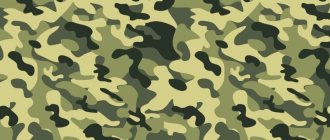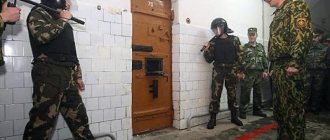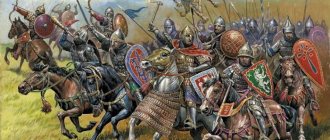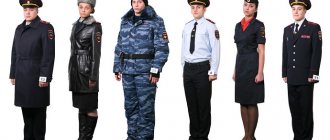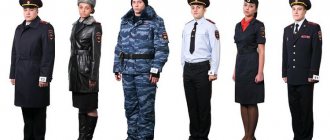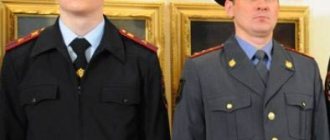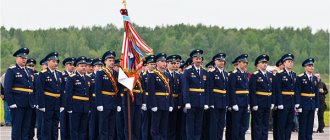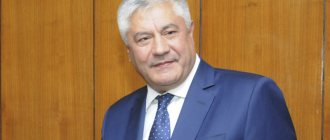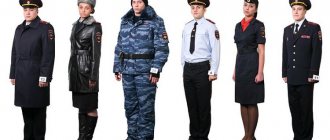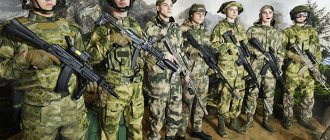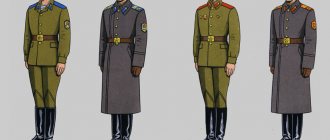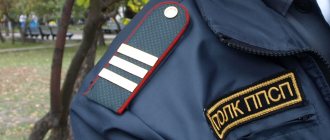Any modern government organization related to the protection of law and order and the solution of more serious problems related to state security has its own form, by which one can unmistakably recognize an employee of this organization. Most often, when the expression “service uniform” comes to mind, the police or the army. The modern uniform of the Ministry of Internal Affairs is the calling card of the police, because for most police officers wearing a uniform is mandatory.
Now there is a lot of talk around the new uniform, which, according to the order of the Ministry of Internal Affairs No. 575, police officers are required to wear. Investigators also have a new uniform. Nowadays, even the generation that went through the Great Patriotic War cannot imagine a police officer (militia in those days) without a uniform. But this was not always the case, because in Russia a special uniform for law enforcement officers appeared only in the 17th century.
The history of the emergence of the Russian Ministry of Internal Affairs from the 17th century to the beginning of the 1917 revolution
Unlike most European countries, in which, until the 18th and 19th centuries, the clothes of law enforcement officers were dark and nondescript, Russian law enforcement officers dressed brightly and flashily, since serving the Tsar was at all times considered a great privilege. In a country where the words “uniform honor” have never been an empty phrase, a beautiful police uniform could not help but appear.
In Russia, which was then called the Moscow State, the first police officers, called zemstvo yaryshki, appeared at the end of the 17th century. It was then that Tsar Alexei Mikhailovich, nicknamed “The Quietest,” transferred the functions of the Robbery Prikaz (which was engaged in the investigation and “knocking out” guilt and testimony) to the Zemsky Prikaz. It was in those days that people’s dislike for the police was rooted, and the Yaryshki received several offensive nicknames, derived from the letters “Z” and “I”, which were embroidered on their chests.
The first uniform of the then police were green Streltsy caftans with a red “Z” and “I” stripe.
In 1718, by decree of Peter I, a real police force was formed. Peter I, who was very responsible about every detail, himself established the uniform that police officers had to wear. According to the decree, the uniform of the first police consisted of the following elements:
- The caftan is bright blue (if you adhere to the exact text of the decree, then “cornflower blue”);
- The same color trousers and cap;
- The cuffs, cap lapels and uniform piping are red;
- Green camisole;
- Black tie.
The police uniform was either red or blue, different sources indicate this differently, perhaps there were two options at the same time.
Until the reign of Empress Catherine II, the uniform of the police, like the uniform of the Russian army, did not undergo any changes, both in Moscow and in provincial Russian cities. This state of affairs lasted until 1775.
In 1775, two acts of Catherine II appeared at once, which not only influenced the uniform of the Russian police, but also laid the foundation for the police hierarchy. The first act was “Institution for the management of the province”, and the second was “Charter of the deanery or police”. The police system that took shape in connection with these acts existed virtually unchanged until the second half of the 19th century.
In 1784, a decree was created according to which the police uniform was as follows:
- A caftan made of cloth with folded tails and a collar;
- Vest or camisole;
- Tricorne hat;
- Trousers;
- Stockings with boots, which were replaced in the equestrian ranks with special over-the-knee boots.
In addition, a sword was necessarily worn as a weapon. The color of the uniform depended on the province to which the policeman belonged:
- In St. Petersburg and the northern provinces the uniform was light blue;
- In Moscow and the surrounding provinces the color of the uniform was red;
- In Kyiv and other southern provinces, the color of the uniform was dark cherry.
Although the uniform was of the same type, the decoration of the uniform varied over a fairly wide range, which depended on the wealth of the owner of the uniform.
Under Paul I, the police were defined as a completely civilian service and independent from the army. In this regard, plaques were added to the police uniform, which depicted the royal double-headed eagle and indicated the position of the owner. The appearance of a junior police rank, a police officer, dates back to the same period, which later became the symbol of the Russian police until the 1917 revolution.
In 1808, the clothing of the Ministry of Internal Affairs of Tsarist Russia was updated. All officials of this ministry received the following form:
- Dress uniform;
- A service uniform of a similar cut.
The uniforms were dark green coats with a high collar and black velvet cuffs. The uniforms had coat of arms buttons made of yellow metal.
Under Emperor Nicholas I, who was a well-known expert on uniforms throughout Europe, a new police uniform appeared, which was introduced in 1834. This uniform was distinguished by a huge variety of different options, which were prescribed to be worn depending on the service functions performed. In any case, the main parts of the uniform were the following elements:
- Dress uniform;
- Vitsmundir;
- Uniform frock coat;
- Uniform tailcoat.
An official's overcoat made of cloth was developed especially for winter. 21 years later, in 1855, when the first police teams appeared, designed specifically to maintain and protect law and order in cities, a new reform of the police uniform took place.
Back in 1854, police officers received galloon shoulder straps, which they wore instead of epaulettes; longitudinal gaps and stars appeared on the shoulder straps, which showed the rank of the owner.
Lower police ranks (city officers) received the following uniform:
- Gray double-breasted semi-caftan;
- Gray trousers with red piping;
- A helmet with the coat of arms of the province to which the policeman belonged;
- A device made of yellow metal.
The weapon of lower police ranks was a massive cleaver, which was worn on a black leather belt.
The “Nikolaev” uniform underwent several changes and improvements, until in 1867 the police uniform underwent another reform. Under Emperor Alexander II, all police uniforms began to be made from dark green cloth. This is the color of all police uniforms.
Under Alexander III, who tried to awaken the “national spirit” in Russia, the uniform of the police (and the army too) began to closely resemble the Russian national folk costume in appearance and cut. Although the new style uniform was undoubtedly comfortable, most police officials considered it unworthy for a representative of the authorities to dress in a uniform of this style. The basis of the new model was a caftan, which did not even have buttons, but was fastened with special hooks. The caftan was dark green.
During the reign of the last Russian Emperor Nicholas I, the role of the police in Russia increased significantly. Due to the increased number of different revolutionaries, the role of the police in maintaining state law and order has increased significantly.
By 1904, the process of modernization of the Internal Troops of the Ministry of Internal Affairs was practically completed and the police suit acquired the form in which it existed until the 1917 revolution. The police uniform for junior ranks became double-breasted, and hooks were used as fasteners. Army-style trousers were used as trousers. The police uniform was worn with a belt that resembled a lancer's sash, or with a black patent leather belt.
The last years of the existence of the police in Tsarist Russia were marred by numerous murders of government officials. Moreover, they were killed both by revolutionaries, who were often criminal elements, and by ordinary crowds of people who staged pogroms.
Firefighters
The fire service was created under Tsar Alexei Mikhailovich, and it was the date of signing the “Order on City Decoration” - April 30 - that became the day of the professional holiday of firefighters.
Uniforms appeared much later. Only in 1802 was a decree of Alexander I issued, which introduced different forms of clothing depending on rank.
The team included city guards and ordinary firefighters. As for clothing, guards and firefighters were provided with a jacket, sash, cap, trousers and an overcoat made of dark gray cloth.
Previously, firefighters' clothing consisted of a jacket and trousers and thick fabric, which did not protect against fire. And for an ordinary firefighter there was a simpler uniform, it consisted of trousers, boots, a gray caftan with blue shoulder straps, a bronze fireman's helmet and a sword belt on the belt, in which there was a special case for an ax.
The head of the fire brigade, the fire chief, also had special clothes. His uniform consisted of a caftan embroidered with silver threads, ceremonial trousers, a bronze helmet with an army coat of arms, boots and a sword.
Interesting fact: until the beginning of the 20th century, firefighters were not allowed to take off their uniforms and boots even at night, since in the event of a fire they were obliged to go to the call as soon as possible.
The modern uniform of firefighters should not only protect them from fire, but also be as comfortable as possible. The uniform of a modern firefighter consists of: a protective jacket, overalls, mask, mittens, helmet and gas mask cover. The suits are made of special fabric that can withstand fire temperatures of up to 800 degrees Celsius.
Uniform of the Internal Troops of the Ministry of Internal Affairs of the Soviet era
In February 1917, a revolution occurred in Russia, which put an end to the history of the Russian police, which by that time was more than 200 years old. Since the main role of the Russian police was to maintain law and order, a wave of murders of police officers, who were recognized precisely by their uniform, swept across the country in unrest. First of all, those police representatives died for whom the words “uniform honor” were not just a phrase. The common people, who suddenly gained power into their own hands, hastened to deal with representatives of the authorities who had been inaccessible to them for two centuries.
On March 10, 1917, the Police Department officially ceased to exist, although by that time it was no longer relevant, since the police at that time no longer existed in Russia. Nevertheless, revolutionaries, concerned about the crime situation on the streets of big cities, began to create voluntary detachments that patrolled the streets. Each such detachment was assigned a commander who knew the area very well.
On March 4, 1917, the first detachments of the Petrograd People's Militia were created. As a uniform, these units used white armbands, on which were written the red letters “G.M,” which meant “city police.” Already in the summer of 1917, an attempt was made to create a unified uniform for the police, but since there were enough other concerns at that time, this project remained at the development stage.
In August 1918, army uniforms were introduced for all branches, one of the original items of which was a canvas raincoat, which was used in the automobile army units of the tsarist army.
The Workers' and Peasants' Militia, which was formed back in 1917, received special care from the Soviet government. This body was supposed to become not only a replacement for the tsarist police, but also a symbol of Soviet power in the eyes of the Russian population. In 1918, at a meeting of the NKVD board, which took place in the fall, a uniform for police officers was approved. It was summer and winter and consisted of the following elements:
- The summer uniform consisted of a jacket with pockets, jodhpurs, a cap and boots complete with windings. Already at that time, the uniform was dark blue, which subsequently accompanied the uniform of the Soviet police for several decades. The jacket was fastened with 5 large uniform buttons. Small buttons were sewn on the collar, pocket flaps, cuffs and collar;
- The winter uniform had a rather unusual color “marengo” (dark gray, with a bluish tint). It was complemented by a Finnish-type winter hat, which had a leather visor and a trim resembling lamb's wool (faux fur). In addition, the winter uniform was complemented by a double-breasted coat with a fur collar, and for guard duty, police officers were required to be issued sheepskin coats.
In the summer, police officers were required to wear brown thread gloves, and in the winter, black leather gloves with lining.
Judging by the information available in the archives of the Ministry of Internal Affairs, in those years there was also a women's uniform, which consisted of the following items:
- Single-breasted black coat;
- French;
- Tunic;
- Skirt and beret.
This uniform was made in a blue color scheme, and women began to be accepted into service in the Soviet police in 1919.
Although the Soviet government took a very responsible approach to the creation of uniforms for the police, until 1923 the main uniform for police officers was a standard military uniform, and women’s options, if they existed, were in single copies.
In 1924, when the situation in the young Soviet country had somewhat stabilized, the police uniform underwent modernization, the main goal of which was to simplify production technology. The main differences of the modernized police uniform were as follows:
- Maroon collars became the same color as bekeshes and French collars;
- The administrative staff now have black buttonholes with white edging;
- The departmental police received turquoise buttonholes with black edging. The uniform received a turquoise edging.
In 1926-27, when the NEP in the RSFSR began to be phased out (it was officially closed in 1931, although it was actually phased out in 1928), the colorful uniform of the Soviet police began to become a thing of the past. Stalin's new totalitarian regime demanded a completely different image of the police, strict and stern, which would instill fear in the Soviet population by its very appearance. Beautiful and elegant overcoats are a thing of the past; in their place came strict single-breasted military overcoats, black, which were fastened with hooks. Winter hats for some time remained the same cut, although they began to be made from black cloth and the same color faux fur. The mounted police, who sported blue uniforms, now dressed all in black, like the rest of the RCM services.
In 1938, the time came for another reform in the field of police uniforms. The entire RKM team received khaki overcoats. The most significant changes appeared in the uniform of the commanding personnel:
- New winter fur hats, which were made of brown fur with a characteristic “cap” of gray-green wool fabric;
- A jacket for everyday wear in steel color;
- White lungs of the jacket;
- Pants for summer are white;
- Winter blue trousers.
The beautiful uniform of the Soviet police, which stood out favorably among the monotonous clothing of the civilian population of the USSR, lasted until 1958. This year, when the country was swept by a wave of democratization, the image of the policeman underwent significant changes:
- The beautiful double-breasted uniform was replaced by a simple blue jacket, which had welt pockets and was cut like a military uniform;
- The only insignia on the new jacket are the shoulder straps and red piping. As for the shoulder straps themselves, sewn-on shoulder straps began to become increasingly popular;
- The casual shirt was blue, and the dress shirt was white. All shirts were worn with the same type of tie with an elastic band;
- Trousers could now be worn untucked by all police personnel, even privates.
After this reform, the colorful image of the Soviet policeman remained a thing of the past forever.
In 1969, a uniform reform took place in the USSR army. In this regard, an order of the Ministry of Internal Affairs was published, which provided for updating the police uniform. The main point of this order was the replacement of the blue color of the police uniform with gray, which remained the dominant color of Russian law enforcement officers until recently. The Ministry of Internal Affairs also ordered that the cut of the police uniform be brought into line with the basic cut of the army uniform. This innovation made it possible to significantly reduce the cost of uniforms for law enforcement agencies.
After this reform, the clothes of the Soviet police began to look like this:
- Jackets, both winter and summer versions, began to be made with turn-down collars and single-breasted. They were fastened with 4 brass buttons. The summer jacket was made from half-wool, and the winter jacket from wool;
- Two raincoats of the same type, one nylon and the other rubberized. All cloaks had a secret clasp, a fastened hood and a belt;
- A coat made of woolen fabric with a turn-down collar, which was fastened with 3 buttons. An army overcoat was left for the mounted police;
- In winter, the uniform was issued with a gray muffler and gloves.
In 1984, a blue-gray summer shirt with short sleeves appeared in the uniform of the Soviet police, which was used for all climatic regions of the USSR.
The uniform of the Ministry of Internal Affairs of the Russian Federation in the 1990s was not much different from the Soviet one. The only example of modernization is camouflage of various colors, which was issued mainly to special forces, riot police, and so on. Many private companies appeared that began to sew some types of uniforms and shoes. The production of field models of uniforms has become especially popular. As an example, we can name, which is one of the most famous Russian companies for the production of uniforms and shoes.
Medical workers
Having heard about “people in white coats,” everyone certainly understands that we are talking about doctors and medical personnel. But when exactly did the white coat become the main component of their uniform?
The history of the appearance of the white coat in Russia is not known for certain. According to one version, gowns were first used by doctors during the Crimean War (1853-1856). The second version claims that doctors at the hospital began wearing gowns. Burdenko in St. Petersburg and this happened only in the 1880s.
In the Soviet Union, the production of medical gowns was carried out centrally. The entire volume of gowns produced for medical personnel was distributed among medical institutions.
Later, when commercialization began, specialized medical stores began to appear where you could buy medical gowns and other goods.
Interesting fact: until the 19th century, doctors did not wear not only gowns, but also no other special clothing. Only surgeons wore an apron and sleeves when performing operations.
The earliest uniforms appeared were among the sisters of mercy, whose work was personally organized by Empress Maria Feodorovna at the beginning of the 19th century. Initially, widows took care of the sick; they were supposed to wear a dark brown dress, which, on the one hand, emphasized their status, and on the other, was comfortable for work.
Widows who passed the test received the status of compassionate patients and wore a distinctive sign for life - a silver cross on a green ribbon.
The first sisters of mercy in Russia appeared by 1844 and also wore dark dresses, which were complemented by white aprons, and their hair was covered with white scarves. In these robes, noble ladies sometimes performed the most difficult work of caring for the wounded and sick.
Already in 1867, according to the charter of the Society for the Care of the Sick and Wounded (later called the Russian Society of the Red Cross), sisters were ordered to wear brown or gray woolen dresses, white scarves and white aprons. The Sisters of Charity also had a distinctive Red Cross badge and a special armband with a personal number.
The authority of the sisters' uniform was so great that during the First World War, spies and other dubious individuals abused the wearing of the sister's dress.
After the white coat began to be used as a uniform for doctors, nurses began to wear it along with doctors.
In Soviet times, the uniform was also intended to establish differences in the hierarchy of personnel. The head nurse's robe differed from the robes of ordinary nurses, scarves were replaced with caps, and operating nurses received an additional apron and gloves.
In the 21st century, white coats may be starting to become a thing of the past, as modern doctors prefer suits that vary depending on their specialty.
For example, emergency workers are offered 3 clothing options depending on the season: light trousers and a shirt or overalls and jackets.
New police uniform and its differences from the old one
At the end of 2011, a new uniform was approved for employees of the Ministry of Internal Affairs, since the old one was outdated and did not meet the requirements of modern realities. According to official information, the wishes of veterans of the Ministry of Internal Affairs services were taken into account when developing the new uniform. A new uniform has appeared for all units of the Ministry of Internal Affairs, including the traffic police, the investigative committee, and even cadets.
Allegedly, the new form has become much more practical and convenient. When creating it, the latest materials were used, which have increased durability and wearability. The new uniform looks more dignified than the old one.
The new uniform of the Ministry of Internal Affairs has changed not only its style, but also its color, which has become dark blue instead of gray-blue. According to the manufacturer, the use of the latest fabric samples allows an employee of the Ministry of Internal Affairs to feel comfortable at any temperature.
All employees of the Ministry of Internal Affairs received a new summer and winter uniform. In addition to a completely new everyday uniform, police officers received a new dress uniform, which should emphasize the prestige of serving in the police.
In addition to summer and winter uniforms, a demi-season option is also provided for police officers. For rainy weather, the new uniform provides a modern waterproof suit, instead of a raincoat, which was used by the Soviet police.
Thanks to the use of the latest materials, the new uniform has a presentable appearance in any weather. Worsted fabric, which contains lycra and wool, can repel dust and moisture while being virtually wrinkle-resistant.
Despite all the benefits described, police officers accepted the new uniform with distrust. During operation, it did not show itself in the best way; there are especially many complaints about the summer uniform, which practically does not allow the skin to breathe. At the warehouses they note that the police tried to get the old-style uniform, in every possible way refusing the new “improved” one.
New uniforms for various services of the Ministry of Internal Affairs
The new form for traffic police officers consists of the following elements:
- Demi-season jacket with hood;
- Winter jacket with a fur collar, which is removable. There are emblems on the collar, and the jacket itself has a hood that can be removed;
- Demi-season trousers;
- Insulated winter overalls. There are reflective stripes on the sides of the trousers;
- Summer jacket and trousers with a straight silhouette;
- Wool-blend sweater;
- Shirts with long and short sleeves.
For special purpose police units, uniforms were developed taking into account all the tasks that may arise during their difficult work. An interesting solution, for example, is the presence of special ear holes, which are found in the hoods of new riot police jackets. This allows you to use headphones without removing the hood and provides the audibility that is essential during operational tasks. This feature of the jacket was developed precisely at the request of special forces, who successfully tested it when working with radio headsets.
To ensure that various weather conditions do not interfere with the performance of duty, winter trousers and jackets of riot police are equipped with special bags that are stored in pockets. If necessary, you can quickly put winter clothes in these bags to change clothes in accordance with new weather conditions.
In the new police uniform, the functions of fasteners are performed not only by zippers, but also by Velcro. Although they are designed to make life easier for employees of the Ministry of Internal Affairs, they actually represent a constant headache, since they often lose their properties during operation.
The summer riot police uniform has ventilation valves in the armpit area. In addition, the equipment set includes tactical gloves made of leather and textile. Boots for riot police officers (high boots) are made of thick leather, which is coated with a water-repellent composition.
Uniforms of USSR police officers
1970-1980s can rightfully be called the “golden age” of the USSR Ministry of Internal Affairs, which was actually identified with the police. The latter was even, to some extent, structurally enshrined: on February 11, 1969, the Main Police Directorate (GUM) was disbanded, and independent Directorates were created on its basis within the USSR Ministry of Internal Affairs.
Minister N.A. Shchelokov, taking advantage of the patronage and personal trust of L.I. Brezhnev, who received the military rank of army general, not only created another power structure, but also took care of its authority among the people and the party. With his confident actions, the minister made it clear: the Ministry of Internal Affairs occupies its necessary place in maintaining order in the country and enjoys the full political trust of the leadership.
“For the cause he [N. A. Shchelokov] took on it zealously. The ministry was renamed, wages increased significantly, including with the introduction of bonuses for rank and length of service. According to the benefits provided, the police were actually equal to the army. Special higher educational institutions and even the Academy of the USSR Ministry of Internal Affairs were created.”
— V.I. Kalinichenko, former investigator for particularly important cases under the Prosecutor General of the USSR
Against this background, the introduction of a new uniform for police officers - modern, with a bright aesthetic component - no longer looked like a simple simplification in order to reduce the cost of production, as it might have looked in 1958 and even in 1965.
The most important thing was the change in the color of the uniform: from blue (not very practical, given the low quality of the material, it quickly fades and fades) to a dark gray (“marengo”) color - more economical, non-staining and durable to wear. Although the administrative and economic department proposed leaving the blue uniform with minor changes as one of the options, the choice of the Minister was already completely determined.
New uniform 1969
| External images | |
Cockade with an emblem for the cap of police officers mod.
1969 District inspector I. Aniskin (M. Zharov) in the summer uniform of a police major mod. 1969 (Film “And Aniskin Again”). By order of the Ministry of Internal Affairs of the USSR No. 230 of 06/03/1969, new uniforms of dark gray (“marengo”) instead of blue were introduced to police personnel. There was a return to the already forgotten basic colors of the 30s. The use of double (silver and gold) instrument metal was abolished - now all cockades, buttons, sewing, emblems, insignia, etc. were made only in the gilded version. Shoulder straps for shirts were made with a braid pattern. In this color scheme, the Soviet police would exist until its end - until December 1991.
The same order for all employees, except for mounted police units, abolished the wearing of an overcoat and introduced a double-breasted woolen coat; For the mounted police, a dark gray double-breasted overcoat with six army buttons was introduced.
For all employees of all Main Directorates and police departments of the Ministry of Internal Affairs of the USSR, the following were introduced to wear:
a)
ceremonial
jacket for police commissars, an open single-breasted dark gray color with four buttons, cut in the 1965 model with ceremonial embroidery in the form of laurel leaves on the collar and cuffs, similar to the 1965 uniform, but in gold color, as well as yellow gold soutache and red trim on the collar and cuffs; The ceremonial tunic was accompanied by shoulder straps of golden braid with white embroidered stars. A white shirt of the established pattern and a tie are worn with a ceremonial uniform jacket.
b)
Everyday
jacket (summer - made of lightweight fabric, winter - wool) - similar to the dress jacket;
- for police commissars there is small embroidery on the collar in the form of laurel leaves, a collar and cuffs with red piping; gray shoulder straps;
- for all other employees - red buttonholes with the emblem of the 1966 model, without edging; white casual jacket (for commissars) - similar to the gray one, but without sewing, with gray-steel light sewn shoulder straps.
A gray shirt with a dark gray tie is worn with a gray casual jacket; with a cap and cover, a white shirt; with a beige casual jacket (for commissars) - a light beige shirt with a gray tie and gray trousers with stripes, untucked.
c)
Everyday
cap - with a dark gray crown enlarged compared to 1965 and a red band, with red piping and a filigree (truncal) strap with two small buttons; for wearing in summer (except for commissars), a white cover is installed on the crown; with a cockade and an emblem made of laurel leaves of the established pattern;
- police commissioners have a cockade with golden embroidery on the band, but after a few months the sewing was canceled, and for commissars, as well as police colonels, a cockade without an emblem was installed (additionally established by Pr. No. 439 of December 22, 1969 and Pr. No. 133 dated May 4, 1970).
d)
Casual summer
cap for police commissioners - with a white crown and white lining.
e)
ceremonial
cap for police commissioners - similar in shape and color to the everyday one; with sewing on the band in the form of golden laurel branches, as well as on the visor of the cap and a strap made of thin leather (like the generals of the Soviet Army and internal service) with a cockade of the established pattern.
f) Dark gray trousers with stripes (for police commissioners) and piping for wearing untucked or in boots (at a shooting range, in a shooting range, in a garage, when patrolling the territory on a motorcycle, in rural areas). As practice shows, trousers and boots were always worn with equipment (when wearing a PPS or in an outfit), although the Rules for Wearing this were not strictly formally established.
g) For police commissioners:
- ceremonial
coat in steel color, double-breasted, with three uniform buttons; turn-down collar, with police commissar buttonholes of the established pattern with gilded embroidery; - everyday
coat of dark gray color, the cut is the same as a dress coat; - coat
with a hidden fastener with a belt in the color of the coat with a plastic buckle, buttonholes and shoulder straps.
h) For the commanding staff of the police (except for police commissioners):
- casual
coat , dark gray, double-breasted, straight cut, with three uniform buttons. The collar is turn-down (without the possibility of fastening “tightly”, similar to an overcoat), at the ends of the collar there are buttonholes of the established pattern. The right pocket has a through passage to the weapon. Sleeves with two uniform buttons. The back has a seam in the middle and a strap consisting of three parts, the middle part of the strap is fastened with two shaped buttons; wearing equipment over a coat was not provided; - summer
coat of dark gray color, double-breasted, slightly fitted, fastened with three uniform buttons. The collar is turn-down; buttonholes with emblems of the established pattern are attached to the ends of the collar. - a nylon raincoat with a belt and a secret fastener - the cut is similar to the cut of a summer coat for police commissioners.
- a dark gray rubberized raincoat, single-breasted, with a secret fastener, a belt and a fastened hood. Turn-down collar without buttonholes, shoulder straps, with emblems.
i) For ordinary personnel:
casual
coat of dark gray color, double-breasted, straight cut, with three uniform buttons. The collar is turn-down (without the possibility of fastening “tightly”, similar to an overcoat), at the ends of the collar there are buttonholes of the established pattern. The right pocket has a through passage to the weapon. Sleeves with two uniform buttons. The back has a seam in the middle and a strap consisting of three parts, the middle part of the strap is fastened with two shaped buttons; There was no provision for wearing equipment over a coat.
j) For commanding officers and rank-and-file personnel for winter uniforms - a hat with earflaps
gray fur with a cockade of the established pattern. The hats of commissars and colonels are unchanged. In addition to hats, generals and colonels are entitled to hats with earflaps made of gray astrakhan fur.
For all commanding and private tunics (except for police commissars - their shoulder straps only changed color (everyday and summer) and device (ceremonial)) a new type of shoulder straps was introduced: in the shape of a rectangle with a rounded upper side, at the upper edge of the shoulder strap there is a small uniform button. The field of shoulder straps is made of viscose seamless braid of gray color with edgings and gaps of red color. The ranks of junior commanding officers are indicated by yellow braid stripes.
The removable shoulder straps on the shirt are of the existing design, but with imitation galloon.
For female police officers, the elements of the 1965 uniform remained unchanged, with the blue color replaced by dark gray and the silver device completely replaced by gold.
Table: Insignia of police officers of the 1969 model.
| Higher command staff (for overcoat, dress and casual jacket, summer shirt) | |||||||||||
| Police Commissioner 1st Rank | Police Commissioner 2nd Rank | Police Commissioner 3rd rank | |||||||||
| Shoulder straps | |||||||||||
| Senior and mid-level command staff (to the overcoat and jacket, to the summer shirt) | |||||||||||||
| Police Colonel | Police Lieutenant Colonel | Police Major | Police captain | Senior police lieutenant | Police Lieutenant | Junior police lieutenant | |||||||
| Shoulder straps | |||||||||||||
| Junior commanding officers and rank and file (to the jacket and overcoat, to the summer shirt) | ||||||||||
Police sergeant | Senior Police Sergeant | Police Sergeant | Junior police sergeant | Police private | ||||||
| Shoulder straps | ||||||||||
Changes in clothing in the first half of the 70s.
Despite the relative integrity and completeness of the new dress code reform, private transformations and improvements continued further - strengthening, first of all, the aesthetic aspect of the appearance of a police officer of the USSR Ministry of Internal Affairs.
The following changes were made:
- The everyday summer
uniform for
police commissars
is a light steel-colored jacket and cap, blue trousers with stripes, and a light gray tie; the cut and edging of the jacket, as well as sewing, are the same as for ordinary everyday ones (Project No. 271 of 08/10/70). A year later, in the summer, police commissioners were additionally allowed to wear a summer cap, a white tunic with blue trousers with stripes, untucked (Pr. No. 262 of September 16, 1971). Since the summer of 1975 (already police generals) have been allowed to wear a white shirt with blue trousers in their everyday uniform.
Badge of a policeman on duty in the Minsk metro. 1984-1991
- Etc. No. 354 dated October 20, 1970, cotton winter and summer dark blue suits were installed as workwear for instructors and handlers of detection dogs, as well as for employees working with detection dogs.
- The cut of the coat
for privates and commanding officers of the police changes: it becomes fitted rather than straight, and, although it is still fastened with three uniform buttons up to the beginning of the lapel, it has four uniform buttons (in two rows); completely, the design of the strap was changed (Project No. 76 of 03/22/1971). Obviously, these changes did not make the cut of the coat successful in the eyes of both the police and the authorities, so further changes are not far off: Pr. No. 248 of 08/31/1971 changed the cut of coats for women; Etc. No. 354 of December 20, 1971, for police commissioners, a red edging is introduced along the edges of the sides, collar, flaps and strap for dress, weekend and everyday coats; Etc. No. 299 of November 13, 1972, the cut of the ceremonial and weekend coats and everyday coats for commissars, commanding officers and rank-and-file police officers was again changed. The coat now fastened with three buttons when the lapels were open and five when fully buttoned. It is now possible to wear equipment over the coat (with the fastening “tight”, i.e., with all the buttons). - The shoulder straps of sergeants and foremen
acquired a new look (Project No. 76 of March 22, 1971): the insignia on them is not strips of galloon, but metal corrugated golden strips on clasps. The sergeant's shoulder straps are solid woven, made of viscose braid or silk with a golden stripe. - For employees of sobering-up centers (junior commanders and rank-and-file personnel), wearing a bandage with the inscription “ special medical service
” on their service uniform was abolished. Instead, a cockade with an emblem was introduced onto the service cap - a red cross in a round white field with a gold border in a circle framed by seven golden laurel branches on each side (Pr. No. 95 of 04/01/1971). - For female employees, the hat with ear flaps and beret were abolished; introduced - a fur hat with a cockade and a hat (“kepi”) made of felt with a filigree (truntal) golden strap and a cockade (Pr. No. 248 of 08/31/1971).
- A white summer shirt with short sleeves was introduced to be worn without a jacket and without a tie with an open collar, the cut is the same as a gray shirt, with shoulder straps like on a gray shirt (Project No. 192 of 07/03/1972). Literally in a year, a white summer shirt with long sleeves and a tie will be introduced, but with shoulder straps to match the shirt.
- For police commissars (Pr. No. 312 of November 24, 1972), insulated field uniforms were introduced, modeled on army general uniforms, but in a dark gray color.
Uniform of police generals
Sewing on the collars of uniforms of police generals (since 1975): ceremonial and weekend uniforms, summer casual and everyday jackets.
Sewing on the bands of the ceremonial caps of commissars (since 1975 - generals) of the police mod. 1969 In 1973, in pursuance of the decision of the Presidium of the USSR Armed Forces and the Council of Ministers of the USSR, by Order of the Ministry of Internal Affairs of the USSR No. 350 of November 15, 1973, police commissars were recertified as police generals
. The special ranks of “police commissioner of the 1st, 2nd and 3rd rank” were abolished, their holders were awarded the corresponding general rank of “major general of police” (those with the special rank of “police commissar of the 3rd rank”) and “lieutenant general of police” (“police commissioner of the 2nd rank”). There were no employees with the rank of “police commissioner of the 1st rank” in active service at that time, and the special rank itself had not been awarded since the 40s, so the special rank “Colonel General of Police” was also not introduced in 1973 and was not assigned[22].
The introduction of general ranks in the police system of the USSR Ministry of Internal Affairs also led to changes in the uniform two years later (Order of the USSR Ministry of Internal Affairs No. 140 of 06/02/1975).
Generals
received for the dress uniform:
- an open double-breasted uniform (cut similar to a general's) dark gray with gold shoulder straps and ceremonial embroidery on the collar and cuffs;
- white regular shirt with black tie;
- ceremonial cap with cockade and sewing of existing design;
- dark gray trousers with untucked stripes;
- for the combat uniform - an embroidered general's belt.
The following were established for the daily uniform:
- an open tunic of a dark gray color (epaulets matching the tunic, gold embroidered leaves on the collar) with dark gray trousers untucked, with stripes;
- an open jacket of a light gray color (epaulets matching the jacket, gold embroidered leaves on the collar) with untucked dark blue trousers, with stripes.
All jackets with edging of the existing sample. Caps - no changes.
No change - winter uniform.
Thus, the uniform of police generals became similar to the army generals or the uniform of generals of the internal service, with the exception of the color scheme.
Additionally, for police generals, a bekesha made of dark gray woolen fabric, double-breasted, lined with fur or batting, with a hidden fastening with buttons and hooks was introduced. Bekesha could wear burkas and felt boots - just as army generals wore her.
Special form
Another innovation that had a definite impact on the further evolution of the police uniform. Order of the Ministry of Internal Affairs of the USSR No. 199 of 07/08/1974 for private and junior command staff of sobering-up stations
special clothing
has been introduced for wearing while on duty. The overalls consisted of summer and winter suits (jacket and trousers; insulated, single-breasted jacket with a faux fur collar). The summer suit was made of cotton or synthetic fabric. The suit consisted of a jacket and trousers. The jacket is single-breasted, straight, gray, with sewn-on chest pockets with flaps. Turn-down collar. Sewn shoulder straps of dark gray color, with emblems. Trousers untucked with a stitched narrow belt. As subsequent events showed, this uniform was something like an experimental sample of workwear as such.
In the spring of 1976, new changes were made to the service uniform of police officers (pragmatics here again followed aesthetics): a protective helmet, a PVC (polyvinyl chloride) cap cover, an artificial leather jacket, winter and summer suits were installed. For traffic police officers
a fur coat made of sheepskin and a fur suit made of sheepskin were installed (Project No. 106 of 04/21/1976), white traffic police equipment was preserved.
The same order (Pr. No. 106 of 04/21/1976) established as general service uniform for all police officers a uniform similar to that previously established for... ordinary and junior commanding staff of sobering-up stations (Pr. No. 199 of 07/08/1974), since its experience experimental application turned out to be successful.
Ceremonial weekend and everyday police uniforms 1975
Buttonholes arr.
1969: 1 - for the coat and raincoat of police commissars (since 1975 - generals) of the police, 2 - for the raincoat of police officers, 3 - for the ceremonial jacket of police officers, 4 - for the everyday jacket of preliminary investigation officers, 5 - for the everyday jacket police officers. By Order of the Ministry of Internal Affairs of the USSR No. 140 of 06/02/1975, two new types of clothing were introduced for all police personnel of the Ministry of Internal Affairs of the USSR: ceremonial and weekend
and
everyday
, previously provided only for police commissioners.
Dress uniform
included the following special elements:
a) Dress uniform, single-breasted of the existing cut, gray (often a slightly lighter shade than everyday) with red buttonholes (with brass edging and emblem) on the collar; the jacket was equipped with shoulder straps of gold braid (in the order - orange viscose braid) of the existing sample with red edging and gaps; the jacket was worn with a white shirt; ceremonial uniform and coat for generals - the existing model;
b) a ceremonial belt for a jacket - woven, golden with a coat of arms buckle (modeled on a similar army ceremonial belt); for police generals - to a jacket and a winter coat; since 1977 - for the ceremonial winter coat of all personnel (Project No. 95 of March 1977).
c) a white muffler for a winter coat.
A cap and insignia on it, a hat (of colonels) and a hat with earflaps, a winter coat - as with everyday uniform.
For formation (in boots) it was expected to wear a ceremonial belt. The coat for the formation was fastened with all buttons.
For everyday uniforms, wearing full equipment was mandatory when performing official duties and serving as teaching staff. Although the Rules provided for the wearing of equipment both with trousers in boots (with a fully buttoned coat) and with boots (trousers untucked, with open coat lapels), film and photographic materials show that the latter option was not encountered in practice until the mid-80s gg.
The remaining elements of the daily uniform remain unchanged.
Table: Changes in police insignia 1971-1977
| Higher command staff (for an overcoat, a ceremonial and everyday jacket, a summer shirt) | ||||||||||
| Lieutenant General of Police | Major General of Police | |||||||||
| Shoulder straps | ||||||||||
| Shoulder straps senior and middle command | ||||||||||
| Senior command staff | Middle management | |||||||||
| Police Colonel | Police Lieutenant Colonel | Police Major | Police captain | Senior police lieutenant | Police Lieutenant | Junior police lieutenant | ||||
| ... to the front dress jacket (uniform) | ||||||||||
| ... to an overcoat and an everyday jacket | ||||||||||
| Junior commanding officers and rank and file (for overcoats, everyday and ceremonial uniform jackets) | ||||||||||
| Police sergeant | Senior Police Sergeant | Police Sergeant | Junior police sergeant | Police private | ||||||
| Shoulder straps | ||||||||||
| Sleeve badge (since 1977 ) | No | No | No | No | No | |||||
| To a rubberized raincoat and a special uniform | |||||||||||
| Senior command staff*) | Middle management*) | Junior command staff | Rank and file | ||||||||
| Shoulder straps | |||||||||||
*) Since 1969
Innovations of the late 70s - early 80s.
Badge of a traffic police inspector of the USSR Ministry of Internal Affairs.
By order of the USSR Ministry of Internal Affairs No. 95 of March 24, 1977, wearing
- cockades with the emblem of a new type
(a cockade of the existing type with an emblem in the form of a wreath of laurel leaves, five pieces on each side, tied with a ribbon at the bottom) for all police personnel (except for colonels and generals) on all headdresses, except caps; - sleeve insignia
for junior commanders and rank and file of the police
- on the left sleeve of the ceremonial uniform (on a dark gray field in a red oval there is a sword and shield with a hammer and sickle in the center; the oval is framed by laurel branches; the entire pattern along the contour is golden colors sewn or made of polyvinyl chloride film); - caps of
a dark gray color with a edging with a small
cockade
without an emblem instead of a summer cap and a hat with ear flaps instead of a fur hat for women; for the cap it is established to wear a cockade with an emblem; - untucked trousers made of dark gray woolen fabric with red piping - for female cavalrymen and traffic police inspectors when performing outdoor and patrol duty.
Since January 1979, cadets of educational institutions of the Ministry of Internal Affairs received the letter “K” (metal, embroidered, polyvinyl chloride) on their shoulder straps, as well as badges (golden (yellow) rectangles on a red lining) on the left sleeve) - according to the number of courses completed.
In the summer of 1980, for police generals, like their army colleagues, sewing was established on the band of everyday caps (Project No. 207 of June 17, 1980).
Sewing on the band of everyday caps of police generals (since 1980)
In the summer of 1984 (Project No. 139 of July 10, 1984), the new Minister of the Ministry of Internal Affairs of the USSR, Army General V.V. Fedorchuk, introduced a gray-blue summer shirt with a turn-down, unbuttoned collar and short sleeves for all climatic regions. The shoulder straps are removable gray-blue. It is noteworthy that the military will officially receive such a privilege only in 1988. The same order changed the shape of the cap for women.
In the mid-80s. The coats of commanding officers and rank and file acquired hooks on the collar - similar to an army overcoat. At the same time, the wearing of uniforms and compliance with the Rules began to be treated more freely: thus, equipment could be worn over a coat with turned-down lapels and with trousers untucked.
By Order of the Ministry of Internal Affairs of the USSR No. 107 of May 31, 1985, a badge was introduced for traffic police officers supervising and regulating traffic.
Changes in the second half of the 80s
By order of the USSR Ministry of Internal Affairs No. 180 dated August 25, 1987, Lieutenant General of the Internal Service A.V. Vlasov made further changes to the existing uniform of the police - in particular, to the cut of the general's cloak and shoulder straps. By the same order, a gray jacket, previously adopted as a special uniform, was introduced as an additional element of everyday uniform for all commanding and rank-and-file police officers (Pr. No. 106 of 04/21/1976).
For women installed
- woolen dress (gray, with a belt, a turn-down collar, chest patch pockets with flaps, an open placket with five small uniform buttons, sleeves with cuffs, fastened with uniform buttons; sewn shoulder straps of dark gray color),
- summer dress (made of lightweight gray-blue fabric, with a belt, turn-down collar and chest patch pockets with flaps, the front of the dress and pocket flaps are fastened with buttons; short sleeves; removable shirt shoulder straps, gray-blue color.),
- trousers - similar to those already installed, but with minor changes.
The same order established the wearing of:
- protective helmet (white plastic cap, transparent protective screen and black chin strap; in the front center of the cap there is a 1977 cockade with an emblem), jacket (made of artificial leather with a turn-down collar, a fastened hood and a fur collar. Fastening with a metal zipper; shoulder straps removable dark gray) and new types of faux leather trousers - for traffic police personnel carrying out surveillance, patrolling or traffic control.
- summer suit, set as special summer clothing
(dark gray jacket, single-breasted, fastened with five uniform buttons, turn-down collar; chest pockets with flaps; sleeves with cuffs; dark gray shoulder straps. untucked trousers made of dark gray fabric colors, there are pockets on the front halves of the trousers (the early version had no pockets, with golden rather than gray buttons)). A gray T-shirt (early version) or vest was worn under the jacket. Boots with high tops and lace-ups have been introduced to complement the summer suit. On new samples, the belt was worn over a jacket and trousers. - The headgear is a summer gray cap, reminiscent of the cap for an army field uniform (“Afghan”). A cockade with an emblem was attached in the center of the finishing detail (since April 1989 - without an emblem, like on caps).
The new uniform was very quickly appreciated and began to be used not only for official purposes, but also for everyday use.
The same order canceled the wearing of the sleeve insignia established in 1977
on the parade uniform of private and junior police officers.
Riot police and their uniform
OMON sleeve insignia Flag on the beret of OMON fighters (1990-1991).
One of the latest and most significant innovations of A. V. Vlasov (since 1987 - Colonel General of the Internal Service) as Minister of Internal Affairs of the USSR was the organization of special police units of the Ministry of Internal Affairs with the widest functions - from the fight against organized crime to the elimination of mass unrest. These units were called special police units (OMON).
Units of this kind with similar tasks already existed within the USSR Ministry of Internal Affairs - the so-called “Specialized Motorized Police Units (SMPM)”, formed in 1966 (Order of the USSR Ministry of Defense No. 03) - they were part of the internal troops and were recruited by conscription, although and had a police uniform and rank system. However, the riot police initially did not copy or repeat the experience of the SMFM. OMON units were staffed only under contract, underwent special training, had a police, not military specification, and were not part of the internal troops of the USSR Ministry of Internal Affairs, subordinate to the Central Internal Affairs Directorate of large cities or (very rarely) directly to the USSR Ministry of Internal Affairs.
REFERENCE:
By the end of 1991, some units (Riga OMON), in certain conditions, were reassigned to Internal Troops units (RizhOMON - 42nd Internal Troops Division), some - directly to the USSR Ministry of Internal Affairs (Vilnius OMON).
On October 3, 1988, A.V. Vlasov signed an Order (No. 0206 dated October 3, 1988) on the formation of 19 riot police units on the territory of the USSR (12 of them in the union republics), as well as on the introduction of a special uniform for these units.
The clothing of the riot police included the following elements:
- gray faux leather jacket (as a rule, dark or black colors were used), shoulder straps - attached, with emblems;
- lace-up boots with big tops;
- summer uniform with a summer cap;
- a special sleeve badge on the left sleeve of the jacket, reminiscent of the badge of 1977: in the middle of a dark gray oval field in a red oval there is a sword with a hammer and sickle in the center, at the bottom of the badge, in the border, on the red field there is the word “police” "; sword, hammer and sickle, oval edging, the word “police” - golden (yellow) color;
- equipment and weapons are standard.
The belt was worn over a summer jacket (in some cases, instead of the usual jacket and trousers, judging by the photo, gray overalls were used, similar in design to the everyday and field overalls of Airborne Forces personnel).
Somewhat later, gray and black berets were installed for riot police units, modeled on those existing in the Airborne Forces, Marine Corps and special forces of the USSR Ministry of Internal Affairs - with a cockade with the emblem mod. 1977, with a red flag in the shape of an elongated triangle on the left side with the emblem - the brass Coat of Arms of the USSR.
Table: Police badges 1969-1991.
| 1 | 2 | 3 | 4 | 5 | 6 | 7 |
| Cockades*) |
*) 1 - 1969-1991 - commissars (since 1973 - generals) of the police, police colonels; uniform for all winter hats (until 1977). 2 - 1969-1977 - for the caps of police officers (except for commissars, generals and colonels) combined. 3 - 1969-1977 - for caps of police officers (except for commissars, generals and colonels) one-piece stamped. 4 - Since 1971 - employees of medical sobering stations. 5 - 1977-1991 - police officers, except generals and colonels - combined (for caps, felt caps and hats with earflaps). 6 - 1977-1991 - police officers, except generals and colonels - all-stamped (for caps, felt caps and hats with earflaps). 7 - for caps (since 1977) and caps (late 80s).
Changes in clothing 1990-1991 Collapse of the USSR Ministry of Internal Affairs system
In the fall of 1989, the Ministry of Internal Affairs of the RSFSR was restored (Ministers - Colonel General of the Internal Service V.P. Trushin, Colonel General V.P. Barannikov, Lieutenant General of the Internal Service A.F. Dunaev) under the current Ministry of Internal Affairs of the USSR (Minister - General Lieutenant V. Bakatin; Colonel General B. K. Pugo; Colonel General V. P. Barannikov).
As part of the reforms ongoing in the country, the process of general decentralization of the Union Department of Internal Affairs begins with broad delegation of powers to the republican internal affairs bodies.
In these conditions, with growing social tension, interethnic conflicts, mass unrest and a general increase in the criminalization of society, the issues of changing or improving the police uniform were inevitably relegated to the background - with the exception of the use and independent production of various non-statutory badges and emblems (usually one or another republican or other local affiliation). These improvised signs were used spontaneously and unsystematically, and therefore are not subject to description within the scope of this article.
Just as common is the mixing of various elements of the uniform, the placement of insignia directly on the shoulder straps (and not on the shoulder straps) of service jackets, the use of everyday uniforms as a dress uniform and everyday uniforms as a service uniform (for example, when dispersing unauthorized rallies and pickets).
The cut of the riot police uniform has changed somewhat, approaching the design of the army field uniform.
In fact, already at the end of 1990 - beginning of 1991, the police were transferred under the jurisdiction of the Ministry of Internal Affairs of the union republics. After the events of August 1991, the USSR Ministry of Internal Affairs lost control over police units and internal troops on the territory of the Russian Federation.
December 1991 finally put an end to the history of the Soviet police.
Film incarnations
- Gentlemen of Fortune (1971)
- Missing Witness (1971)
- Old Robbers (1971)
- Man in the Passage Yard (1971)
- The Very Last Day (1972)
- Take a Look at That Face (1972)
- Dot, dot, comma... (1972)
- Hello and Goodbye (1972)
- The investigation is conducted by experts (1971-1989)
- Ivan Vasilyevich changes profession (1973)
- Big Break (1973)
- Incorrigible Liar (1973)
- The New Adventures of Doni and Mickey (1973)
- The Black Prince (1973)
- Everyday life of the criminal investigation (1973)
- Shah of the Queen of Diamonds (1973)
- Singing Quartet (1973)
- Aniskin and Fantomas (1974)
- Three days in Moscow (1974)
- Five for the Summer (1974)
- Car, violin and dog Blob (1974)
- Tales of Keshka and His Friends (1974)
- Afonya (1975)
- What's going on with you? (1975)
- In secret around the world (1976)
- Spotlight (1977)
- Vesnukhin's Fantasies (1977)
- Mustachioed Nanny (1977)
- Golden Mine (1977)
- A Long, Long Thing... (1977)
- And again Aniskin (1978)
- The Cure for Fear (1978)
- Preliminary Investigation (1978)
- And It's All About Him (1978)
- Colonel Zorin's version (1978)
- Detective (1979)
- Lucrative contract (1979)
- Beware! Snakes! (1979)
- Yeralash, issue No. 22, plot “Farewell, Vasya!” (1979)
- The Adventures of Electronics (1979)
- The City Took (1979)
- Casket of Marie de' Medici (1980)
- Krosha's Vacation (1980)
- Key
- Sailors Have No Questions (1980)
- Petrovka, 38 (1980)
- Ogareva, 6 (1981)
- We the Undersigned (1981)
- Rooks (1982)
- Traffic Inspector (1982)
- In love by choice (1982)
- Inspector Losev (1982)
- Station for two (1982)
- From the life of the head of the criminal investigation department (1983)
- Without much risk (1983)
- TASS is authorized to declare... (1984)
- Attention! All posts... (1985)
- The Stand (1985)
- Life threatening! (1985)
- The most charming and attractive (1985)
- Sincerely yours... (1985)
- Strangers Don't Walk Here (1985)
- Lonely Bus in the Rain (1986)
- Tree sticks! (1988)
- Red Heat (USA, 1988)
- Crime Quartet (1989)
- On the Dark Side of the Moon (ex Silence) (1990)
- Fools Die on Fridays (1990)
- Wild Beach (1990)
- In the Surf (1990)
- Taxi Blues (1990)
- Murder Arithmetic (1991)
- Destroy the Thirtieth! (1992)
- Death Bay (1991)
- Murder on Zhdanovskaya (film) (1993)
- Police Academy 7: Mission to Moscow (USA, 1994)
- Shirley-Myrley (1994)
- Cargo 200 (2007)
- Serebryany Bor (2017)
- Inside Lapenko (2019)
- Murderers (2019)
- Alex Lyuty (2020)
- Casanova (2020)
- Chernobyl (2021)
- Mosgaz. Trap (2021)
New women's police uniform
Women working in the police are allowed to wear dress pumps. The height of the heel should not exceed 4.5 cm. For women who carry PPS, trousers and a jacket are provided as a uniform, which is adjusted to the figure using lacing. Female investigators have the option to choose between a skirt, trousers and a dress. Women's demi-season jackets are made from genuine leather.
When designers developed models of women's uniforms, they supplemented them with red neck scarves that can be worn instead of a tie. The bow tie that was in the old uniform was removed due to a lot of negative comments being made about it. As headdresses, girls were able to wear felt berets.
Insignia on the new police uniform
The rules for wearing a new type of uniform, as well as the placement of various chevrons, stripes and lapel emblems on it, are reflected in the order of the Ministry of Internal Affairs No. 575, which came into force on July 26, 2013. According to this decree, every police officer is required to wear a badge on the right chest indicating his last name. On the left side of the chest of a police officer’s uniform there must be a special badge on which the police officer’s personal number and his affiliation with any region must be stamped. Affiliation is indicated using 3 letters.
Badges on uniforms are worn not only by patrol officers, but also by employees of the private security department. The badges are made of aluminum, have a golden color and an oval shape. Employees of the road patrol service have badges in the shape of a circle.
New police uniform chevrons
There were chevrons on both the old and new police uniforms. The chevrons indicate the unit to which the police officer belongs. According to the law, there are 15 different versions of chevrons, which are intended for various parts of the Ministry of Internal Affairs. Each unit has its own emblem, which is depicted on a chevron. For the riot police it is a sword and wings, for the special police force it is a fortress and a key, and so on. Chevrons, as well as other elements of the uniform of the Russian police, are complemented by various reflective elements that facilitate the identification of an employee of the Ministry of Internal Affairs in the dark.
Chevrons should be sewn onto the sleeves of jackets, peacoats and tunics. An innovation has been introduced for the new uniform that was not in the old uniform - now chevrons must be sewn onto long-sleeved shirts. The chevrons for the new police uniform are made to match the color of the clothing, and come in white, blue, blue-red. On the new form, chevrons can not only be sewn on, but also secured with Velcro.
All chevrons that are attached to uniforms in one way or another must be sewn on the right sleeve. The distance at which they are attached should be 8 cm from the edge of the shoulder. For employees of internal affairs bodies, a special inscription “police” is provided, which should be located above the left breast pocket.
Operation and maintenance of the new police uniform
Despite the fact that the new form is positioned as simpler and more convenient to use, caring for it differs from caring for the old form. Thanks to the use of modern fabrics and materials, this uniform is not intended for self-washing. The instructions strongly recommend that you dry clean it. Many employees of the Ministry of Internal Affairs have learned from their own experience that doing laundry on their own can lead to unexpected and disastrous results.
The history of the Russian police uniform is very interesting and entertaining. Many hope that the next reform of police clothing will not be aimed at reducing the cost and depersonalization of the uniform, but will give it a unique flavor, while not forgetting about ease of use.
New sample form
Despite the fact that the order to “change clothes” for the police was issued back in 2013, until recently, police officers in the old uniform could be seen on the streets of some cities. You can distinguish it from the new one by its predominant dark gray color. The reason for such a slow replacement of uniforms is simple - underfunding. In addition, the scale of the work must be taken into account.
As of 2022, at least 70% of all employees of the Ministry of Internal Affairs were provided with the new uniform (data on the “police itself” was not provided). In April of this year, the government reported that the “change of clothes” plan had already been completed by 95%. Thus, the canceled uniforms should finally disappear this year.
